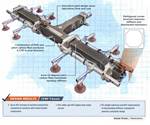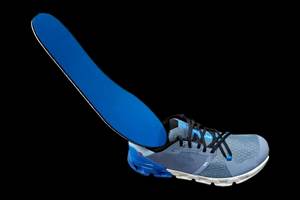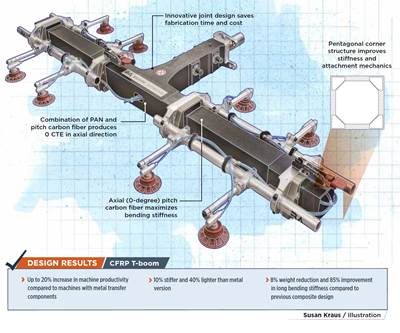A lightweight and high-stiffness CFRP gantry beam enables the Ultimate’s high-speed precision cutting.
Source | CompoTech
CompoTech PLUS (Sušice, Czech Republic) uses its proprietary advanced fiber laying (AFL) and winding technologies to replace steel and aluminum with lightweight carbon fiber-reinforced polymer (CFRP) components, such as telescopic masts, gantries, rotary shafts, spindles, beams and tools for production machinery. Since 2013, an R&D partnership between CompoTech and Kongsberg Precision Cutting Systems (Kongsberg PCS, Kongsberg, Norway) has aimed to reduce operational costs and increase productivity by developing wider, faster, high-precision digital systems for high-volume converters of flat and corrugated packaging and display materials. Over the years, these objectives have evolved a CFRP gantry design that now provides a new level in machine capabilities.
These automated machines feature a gantry beam that enables a gear-driven cutting head to fly back and forth across the wide table, cutting shapes out of the material beneath. This beam must handle the load from the cutting head, as well as its acceleration and deceleration, resulting in a mix of rotational, shear and skewing forces.
Launched at the beginning of 2024, the new Kongsberg Ultimate digital cutting machine features a latest-generation CFRP beam, designed not to simply replace an aluminum part, but to optimize the use of composites and CompoTech’s design and manufacturing technologies. The Ultimate has received awards in Europe and the U.S., lauding its quantum leap forward in technology and performance for print and packaging producers.
Production innovation partnership
Founded in 1965 near Oslo, Kongsberg PCS has a multinational presence, with centralized production in Brno, Czech Republic, a global head office and customer experience center in Ghent, Belgium and North American headquarters in Dayton, Ohio. In 2021, Kongsberg acquired MultiCam Inc. (Irving, Texas, U.S.), a global supplier of laser, plasma and waterjet cutting machines and CNC routers.
As it began working with CompoTech, a key objective for Kongsberg was to reduce operational costs and increase productivity by developing wider cutting systems that could also increase speed and precision. CompoTech worked closely with Kongsberg’s R&D team to achieve this. “Our first development was a 4-meter-long CFRP gantry beam for the Kongsberg C6 series, which featured a 25% wider, 3.2-meter-wide table,” says Dr. Humphrey Carter, head of business development for CompoTech. “Our CFRP beam had to match the profile of the original aluminum beam to keep componentry consistent but also had to match its deflection even though ours was 1 meter longer. We achieved that, and it worked really well.”
“For the Ultimate machine, however, Kongsberg gave us free rein with the section profile to get the most out of the material and performance,” says Carter. “We could really optimize the design for composites, to make it as stiff and light as possible. The final design has the added benefit of being produced more efficiently in a single fiber winding step versus the two-step process required for the C6 series beam.”
Foam-cored design, pitch and PAN fibers

For the Kongsberg Ultimate, CompoTech selected its in-house developed foam-core integrated beam structure to maximize stiffness and minimize weight. The final design gantry weighs only 70 kilograms with a modulus of 230 GPa in the main beam laminate and a deflection under load of only 200 micrometers.
This very high bending stiffness is achieved by placing ultra-high modulus (UHM) pitch carbon fiber axially along the beam, made possible using CompoTech’s “true zero-degree placement” technology. “Pitch fiber offers higher modulus than the more typical carbon fiber based on polyacrylonitrile [PAN] precursor,” says Carter, “but it is also a more fragile fiber and can lose properties if not handled correctly.”
“Our ability to design and manufacture highly optimized structures by placing pitch fiber is a specialty we have perfected,” adds Dr. Ondřej Uher, R&D director for CompoTech. Carter notes the Ultimate’s gantry beam also uses standard and intermediate modulus PAN fibers plus a standard long-cure epoxy resin. This combination of materials is used to reduce the beam’s rotational stiffness via stiffening wound into the structure before being overwound with the final outer laminate. “This design provides a high level of natural frequency damping which has contributed to the much higher cutting speeds and accuracy in the new Ultimate machine,” adds Uher.
Increased acceleration with precision cutting
The digital cutting head mounted on the Kongsberg Ultimate gantry traverses the cutting table along aluminum rails. “The rail fixing system runs along the entire length of the beam,” says Carter. “The new beam design for the Ultimate’s gantry needed to accommodate a larger digital cutting head, which applies up to 50 kilograms of downforce and creates a lot of torsional stress.”
“For a cutting table, it is the acceleration that matters most and gives the performance, combined with the stiffness of the gantry beam,” explains Thomas Malme, R&D chief engineer at Kongsberg PCS. “Getting the cutting head up to maximum speed and back down to zero again as quickly as possible is more important than the maximum speed.”
To enable this and the high level of cutting accuracy required, CompoTech developed an innovative approach for affixing these rails to the CFRP gantry beam. This included a system of innovative inserts in the internal structure and machining for accurate mounting surfaces after the beam had been pressed and cured.
Industry success, future developments
The collaborative approach by CompoTech has been key to the Kongsberg Ultimate’s success, says Malme. “We looked at all design areas, both hardware and software, where we could make the Ultimate as fast as possible without compromising cutting accuracy,” he notes. “The new high-torque motor drive combined with CompoTech’s new design gantry beam is what enables the Ultimate’s maximum XY linear acceleration of 2.7 G and linear cutting speeds of up to 2.8 meters per second. With the right cutting tool fitted, it can cut and crease materials up to 30 millimeters thick with a high degree of accuracy.”
Carter adds: “The previous design, the C6, was much lower in acceleration, only 7 meters per second, compared to 2.7 G (26.5 meters per second) so it is not really comparable, as we have gone from a 120 × 120 profile constrained by the previous design specification to a 150 × 150 optimized profile.”
Kongsberg PCS and CompoTech continue to explore innovative new product developments. “We’ve been able to demonstrate the advantage when structures are created to make the best use of composites,” says Carter. “We look forward to the next challenges from Kongsberg PCS and our continued collaboration.”
Related Content
Composite wrap system combats corrosion in industrial tank repair
A fiberglass and carbon fiber composite wrap system enabled an Australian nickel mine to quickly repair a stainless steel ammonium sulphate feed tank and protect against future corrosion.
Read MoreRunning shoe insoles get a lift with thermoplastic fiberglass tapes
FlexSpring insoles take advantage of unidirectional, continuous fiberglass and thermoplastics to enable next-level performance for the everyday runner.
Read MorePull-wound carbon fiber poles enable lightweight, compact, rigid emergency stretcher
Based on military feedback, Epsilon Composite developed an optimized, foldable stretcher that combines telescopic pull-wound carbon fiber tubes.
Read MoreDesigning an infused, two-piece composite baseball bat
With its Icon BBCOR bat, Rawlings leveraged its experience in braided fabrics and RTM to create an optimized, higher-performance two-piece design.
Read MoreRead Next
CompoTech announces LaserWay project developments
Performance, process robustness and novel technology integration into laser machines aims to set new precision, speed and sustainability benchmarks for composite part manufacturing.
Read MoreComposite T-boom accelerates industrial automation
A manufacturing method that integrates filament winding with axil winding of 0-degree fibers opens new design options in industrial automated equipment.
Read MoreCFRP planing head: 50% less mass, 1.5 times faster rotation
Novel, modular design minimizes weight for high-precision cutting tools with faster production speeds.
Read More
























